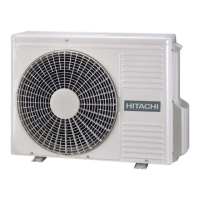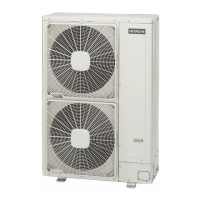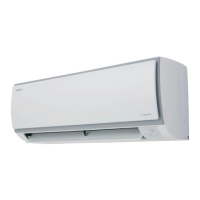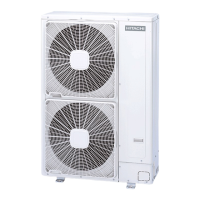Phenomenon Cause Check item
Action
(Turn OFF the main
switch)
Activation of the high-
pressure switch due to the
excessively high discharge
pressure
Insufficient Air Flow to the Heat Exchanger (Outdoor Heat
Exchanger during the Cooling Process or Indoor Heat
Exchanger during the Heating Process)
Check the heat exchanger
for dust or for clogging
Remove the dust or the
clogging
Check the air filter for dust Remove the dust
Check for any obstacles at
the inlet or the outlet of the
heat exchanger
Remove the obstacles
Check the service area Secure service area
Check the speed (Outdoor
Fan: Cooling / Indoor Fan:
Heating)
Replace the fan motor if
faulty
Malfunction of the Expansion Valve
Disconnected of the
Connector
Fix the looseness or
reconnect the connector
Fully closed and locked
Replace the expansion
valve
Excessively High Temp. Air to the Indoor Unit
Calculate the heat load
Reduce the heat load or use
a bigger unit
Check for hot air near the
ceiling (Heating)
Provide good circulation
Check for short-circuited air
(Heating)
Remove the short-circuited
air
Check for other heat source Remove the heat source
Faulty High-Pressure
Switch
Faulty Pressure Switch
Measure the discharge
pressure. Check the
continuity after the decrease
of the pressure
Replace the pressure switch
if faulty
Insufficient Contacting
Measure the resistance by
means of the tester
Fix the looseness. Replace
the connector
Incorrect Connection Check the connections Repair the connections
Activation of the high-
pressure switch due to the
excessively high discharge
pressure
Faulty or malfunction of the expansion valve
Check for clogging Remove the clogging
Check the connect wiring
and the connectors
Replace the connector
Check the operation sound
from the coil
Replace the coil
Check the discharge gas
thermistor
Replace the thermistor
Check the attaching state of
the discharge gas
thermistor
Reattach the thermistor
Faulty gas bypass solenoid valve Check for clogging
Replace the gas bypass
solenoid valve
Overcharged refrigerant
Check the cycle operation
temp.
Charge the refrigerant
correctly
Mixture of the non-condensate gas in the refrigerant cycle
Check the air temp. and the
pressure
Recharge the refrigerant
after the vacuum pumping
Clogging of the discharge piping Check for clogging Remove the clogging
Liquid line stop valve or gas line stop valve is not in
operation
Check the stop valves Fully Open the stop valves
Clogging of the check valve Check for clogging Replace the check valve
8 Troubleshooting
209
SMGB0060 rev. 1- 12/2010
8

